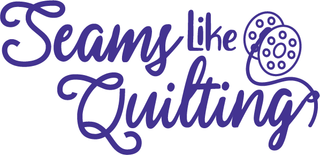From the outside, so much of quilting looks tedious. Big pieces of fabric cut into smaller pieces of fabric and then sewn together again to make…big pieces of fabric. But every quilt is the result of a series of choices by the quilter or quilters. Some of us enjoy steps like trimming HSTs or basting and some do not. Squaring up blocks is one of those tasks; enjoyable for some and tedious for others. Squaring up blocks really helps when putting together the complete quilt top, whether sashing or sewing the blocks directly together.
The first step is to press your blocks. At Seams Like Quilting, we really like wool pressing mats and clappers to help flatten blocks. And it’s important to press your seams instead of ironing your blocks. This will prevent accidentally stretching the edges of your block or any pieces that may be cut on the bias. Pressing on the wool mat and using the clapper to weight the seam while holding the heat will create flat and even seams in your blocks.
Once your blocks are nice and flat, you’ll need a square acrylic ruler and sharp rotary cutter. We recommend a 12.5” square ruler as a general rule, or the same size as your block if you prefer. But a ruler the same size or larger than your block with a marked 45-degree angle will help with the squaring.
Line up your block using the 45-degree mark along with the horizontal and vertical alignment. If your block is bigger than your target size, the 45-degree line will help you ensure you keep your center in the middle while you trim one horizontal and one vertical size.
If your block is too small, you will need to measure the size the block should be and establish a seam line on the block that will be a quarter inch seam on all adjoining blocks. The easiest way to do this is create a foundation block, either with freezer paper or muslin.
Cut a block from your foundation the size your block should be. Mark 45-degree diagonals from corner to corner to create a giant x in the middle of the block. Then mark a seam line a quarter inch from the edge on all four sides. Align the middle of your pieced block with the foundation and attach. If you’re using freezer paper, simply ironing on the paper will work. If you’re using muslin, a few basting stitches will hold flatter than most pins (unless you’re using the super flat Magic Pins we carry at the shop). Then, with the foundation still attached, sew block to the adjoining blocks or sashing. Once all 4 seams are completed in piecing the final top, you can remove the foundation.
When you take the time to square up each and every block, the entire quilt seems to fall into place in the next step. Borders will fit better, and your final quilt will be much more square.

